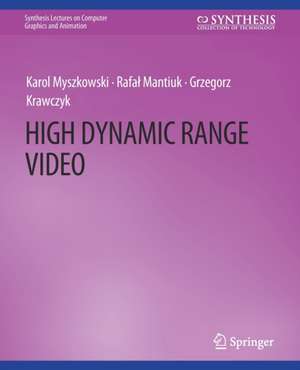High Dynamic Range Video: Synthesis Lectures on Visual Computing: Computer Graphics, Animation, Computational Photography and Imaging
Autor Karol Myszkowski, Rafal Mantiuk, Grzegorz Krawczyken Limba Engleză Paperback – 23 iul 2008
Din seria Synthesis Lectures on Visual Computing: Computer Graphics, Animation, Computational Photography and Imaging
- 20%
 Preț: 180.92 lei
Preț: 180.92 lei - 20%
 Preț: 522.91 lei
Preț: 522.91 lei -
 Preț: 408.91 lei
Preț: 408.91 lei -
 Preț: 261.11 lei
Preț: 261.11 lei -
 Preț: 346.61 lei
Preț: 346.61 lei -
 Preț: 347.19 lei
Preț: 347.19 lei -
 Preț: 382.81 lei
Preț: 382.81 lei -
 Preț: 387.60 lei
Preț: 387.60 lei -
 Preț: 258.05 lei
Preț: 258.05 lei -
 Preț: 380.53 lei
Preț: 380.53 lei -
 Preț: 351.41 lei
Preț: 351.41 lei -
 Preț: 205.32 lei
Preț: 205.32 lei -
 Preț: 190.45 lei
Preț: 190.45 lei -
 Preț: 351.41 lei
Preț: 351.41 lei -
 Preț: 443.21 lei
Preț: 443.21 lei -
 Preț: 443.76 lei
Preț: 443.76 lei -
 Preț: 409.28 lei
Preț: 409.28 lei -
 Preț: 263.01 lei
Preț: 263.01 lei -
 Preț: 234.87 lei
Preț: 234.87 lei -
 Preț: 234.87 lei
Preț: 234.87 lei -
 Preț: 247.72 lei
Preț: 247.72 lei -
 Preț: 191.30 lei
Preț: 191.30 lei -
 Preț: 234.87 lei
Preț: 234.87 lei -
 Preț: 234.87 lei
Preț: 234.87 lei -
 Preț: 234.87 lei
Preț: 234.87 lei -
 Preț: 279.80 lei
Preț: 279.80 lei -
 Preț: 351.41 lei
Preț: 351.41 lei -
 Preț: 234.87 lei
Preț: 234.87 lei -
 Preț: 351.41 lei
Preț: 351.41 lei -
 Preț: 383.71 lei
Preț: 383.71 lei -
 Preț: 191.30 lei
Preț: 191.30 lei -
 Preț: 247.72 lei
Preț: 247.72 lei -
 Preț: 259.38 lei
Preț: 259.38 lei -
 Preț: 264.74 lei
Preț: 264.74 lei
Preț: 263.22 lei
Nou
Puncte Express: 395
Preț estimativ în valută:
50.41€ • 51.94$ • 42.23£
50.41€ • 51.94$ • 42.23£
Carte tipărită la comandă
Livrare economică 22 februarie-08 martie
Preluare comenzi: 021 569.72.76
Specificații
ISBN-13: 9783031795275
ISBN-10: 303179527X
Ilustrații: XI, 158 p.
Dimensiuni: 191 x 235 mm
Greutate: 0.3 kg
Editura: Springer International Publishing
Colecția Springer
Seriile Synthesis Lectures on Visual Computing: Computer Graphics, Animation, Computational Photography and Imaging, Synthesis Lectures on Computer Graphics and Animation
Locul publicării:Cham, Switzerland
ISBN-10: 303179527X
Ilustrații: XI, 158 p.
Dimensiuni: 191 x 235 mm
Greutate: 0.3 kg
Editura: Springer International Publishing
Colecția Springer
Seriile Synthesis Lectures on Visual Computing: Computer Graphics, Animation, Computational Photography and Imaging, Synthesis Lectures on Computer Graphics and Animation
Locul publicării:Cham, Switzerland
Cuprins
Introduction.- Representation of an HDR Image.- HDR Image and Video Acquisition.- HDR Image Quality.- HDR Image, Video, and Texture Compression.- Tone Reproduction.- HDR Display Devices.- LDR2HDR: Recovering Dynamic Range in Legacy Content.- HDRI in Computer Graphics.- Software.
Notă biografică
Karol Myszkowski is a senior researcher in the Computer Graphics Group of Max-Planck[1]Institut fur Informatik. From 1993 to 2000 he served as a tenured Associate Professor at the University of Aizu, Japan, and from 1985 to 1993 he worked as a Research Associate and then an Assistant Professor at the Szczecin University of Technology, Poland. In the period 1986-1992 he collaborated with Japanese company Integra, Inc. developing rendering software for such customers as Toshiba Lighting, Shiseido, Matsushita Electric, Kandenko, and others. He received his MSc degree in control engineering from the Szczecin University of Technology in 1983, and his PhD and habilitation degrees in computer science from Warsaw University of Technology (Poland) in 1991 and 2001, respectively. His research interests include perception issues in graphics, high-dynamic range imaging, global illumination, rendering and animation. Myszkowski has written over 80 refereed publications on these subjects and has served on numerous program committees. He was the Program Committee co-chair of Eurographics Rendering Symposium in 2001, ACM Applied Perception in Graphics and Visualization in 2008, and Spring School of Computer Graphics in 2008. Myszkowski has supervised over 30 graduate and undergraduate research projects.Rafal Mantiuk (PhD from the Max-Planck-Institut for Computer Science, Germany; Msc in Computer Science from the Szczecin University of Technology, Poland) is postdoctoral fellow at the University of British Columbia, Canada. He combines in his research the aspects of human perception, color appearance, image processing, and computer graphics to address the problems of future imaging systems, in which the human eye rather than technology is the major limiting factor. During the last five years he has been involved in research at Max-Planck[1]Institut for Computer Science, Sharp Laboratories of America, and BrightSide Technologies (Dolby Canada). Rafal authored several patents and papers on high-dynamic range (HDR) image and video compression (Proc. of SIGGRAPH’04 and ’06), tone-mapping (ACM TAP, EG’06), developed a fidelity metric for HDR images (HDR-VDP) and co-maintains popular software for HDR processing—pfstools. In 2006 he was granted the Heinz Billing Award for his work.Grzegorz Krawczyk received PhD from the Max-Planck-Institut for Computer Science, Germany and MSc in Computer Science from the Szczecin University of Technology, Poland. During the last five years he has been involved in the research projects in collaboration with the book HDR VIDEO University of British Columbia and BrightSide Technologies (Dolby Canada). His research focuses on the insightful application of knowledge about human visual system to assure high fidelity in high dynamic range (HDR) images and video. Grzegorz authored several papers on HDR tone mapping (Eurographics ’05, ’06, and ’07) and HDR video compression (ACM Siggraph ’04). He also co-maintains a popular software for HDR processing, capture and tone mapping—pfstools, pfscalibration and pfstmo.
